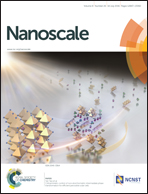Covellite CuS nanocrystals: realizing rapid microwave-assisted synthesis in air and unravelling the disappearance of their plasmon resonance after coupling with carbon nanotubes†
Abstract
Semiconductor nanocrystals that show plasmonic resonance represent an emerging class of highly promising plasmonic materials with potential applications in diverse fields, such as sensing and optical and optoelectronic devices. We report a new approach to synthesizing homogeneous covellite CuS nanoplatelets in air and the almost complete disappearance of their plasmonic resonance once coupled with multiwalled carbon nanotubes (MWCNTs). These nanoplatelets were rapidly synthesized by a simple microwave-assisted approach at a relatively low reaction temperature in air, instead of under N2 as reported previously. These less severe synthesis conditions were enabled by appropriately selecting a Cu precursor and preparing a precursor sulfur solution (instead of using solid sulfur) and by using microwave radiation as the heat source. The advantages of utilizing microwave irradiation, including uniform and rapid heating, became clear after comparing the results of the synthesis with those achieved using a conventional oil-bath method under N2. The CuS nanoplatelets prepared in this way showed very strong plasmon resonance at c. 1160 nm as a result of their free charge carriers at the calculated density of nh = 1.5 × 1022 cm−3 based on the Drude model. With the aim of exploring their potential for near-infrared responsive optoelectronic devices, they were hybridized with functionalized MWCNTs. Their strong plasmon resonance almost completely disappeared on hybridization. Detailed investigations excluded the effect of possible structural changes in the CuS nanoplatelets during the hybridization process and a possible effect on the plasmon resonance arising from the chemical bonding of surface ligands. Charge transfer was considered to be the main reason for the almost complete disappearance of the plasmon resonance, which was further confirmed by terahertz (THz) time-domain spectrometry and THz time-resolved spectrometry measurements performed on the CuS–MWCNT nanohybrids. By extracting the rising and relaxation constants through fitting a single-exponential rising function and a bi-exponential relaxation function, in combination with the results of THz differential transmission as a function of the NIR pump fluence, it was found that hole injection changed the electronic properties of the MWCNTs only subtly on a short picosecond time scale, whereas the nature of the band structure of the MWCNTs remained largely unchanged. These findings aid our understanding of recently emerging semiconductor plasmonics and will also help in developing practical applications.



 Please wait while we load your content...
Please wait while we load your content...